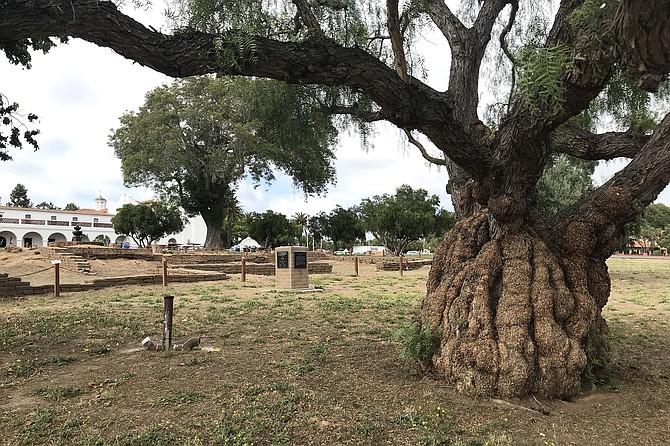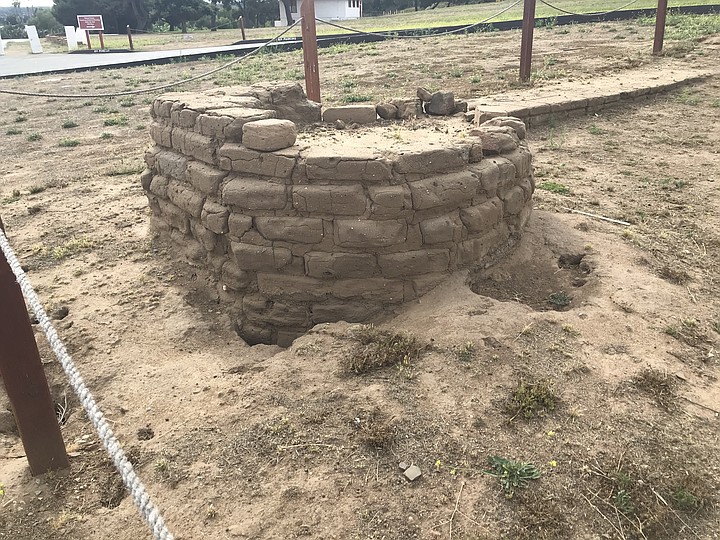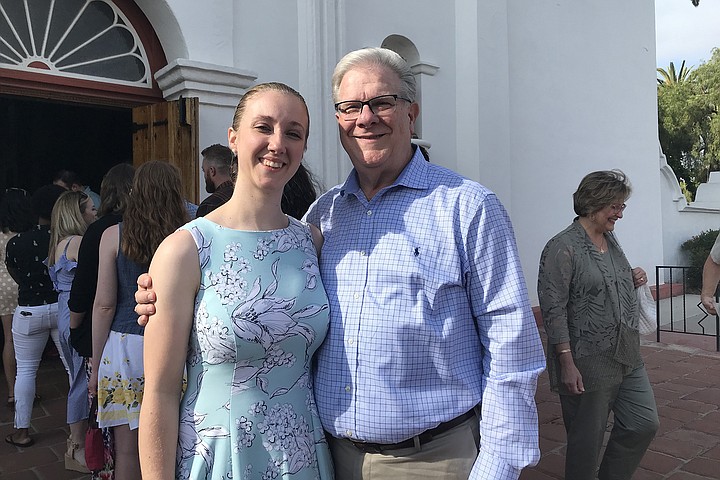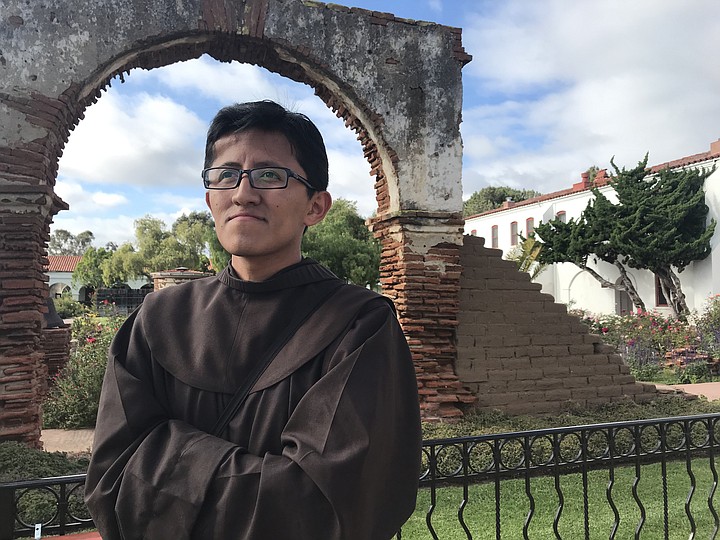 Facebook
Facebook
 X
X
 Instagram
Instagram
 TikTok
TikTok
 Youtube
Youtube

Friar Donaldo Rosete Garcia stands by the old brick arch that frames California’s first pepper tree. “I shall miss this place,” he says, “I came here to learn English. Now I must return to Jalisco.”
To me, Friar Donaldo in his brown Franciscan robe and sandals is the icing on the cake of my accidental discovery of Mission San Luis Rey de Francia, “the king of missions.” This place has been in action since 1798. Two and a quarter centuries later, it still looks countrified. I pass a memorial to the Mormon Battalion, dodge ancient trees, watch for a ton of lethal gopher holes, and come to a big old fountain. It’s like an 18th century Thomas Gainsborough landscape. But the thing is, there’s no-one around. And yet back in the day, this was the center of life, a rancho, raising about 26,000 cattle, plus goats, geese and pigs. And of course “employing” all the “Mission Indians” of the area to work the place.
Then, up at the end of the arched colonnade, I hear voices. A small crowd has gathered outside the church (which has been in business since 1815, the year Napoleon lost the Battle of Waterloo). Inside is stunning, hand-painted, beautiful. Outside, the crowd is being sorted into couples for a processional. “This is my daughter, Lauren Donati,” says her proud dad, Frank. “Tomorrow she is marrying Kevin.”

Kevin Sanchez comes up. Oceansider. He says this was his parish church throughout his childhood. We shake hands. Something about being a cluster of folks in this empty countryside makes it feel very intimate. But now the church lady has them process inside, two by two, to start the dry run. I wander up the colonnade, and through a gate to a garden.
And there is this friar. He stands in his brown Franciscan monk’s robe and white rope belt, looking like St. Francis of Assisi himself. He would have fit right into the Gainsborough.

Somewhere nearby, a bell signals the quarter hour.
“I must go and eat,” says Friar (“Brother”) Donaldo. “The other monks will be waiting. They are mostly older than me. I am 22. We start younger in Mexico. But the old ones here are proof to me that although time passes, the essence remains.”
Out across the electric-green lawn, nuns sweep across, probably heading to the refectory for their evening meal too. Mourning doves coo out their regretful calls, then fly off with their wings swiping the air into musical notes.

But Fray Donaldo tells me they are closing the Franciscan School of Theology here. It’s transferring down to USD. I’m a little saddened that this great old lady, Mission San Luis Rey, is going to have less life in her. Funny that 221 years ago, when this was, for all its colonial faults, indeed the “king of missions” it was probably far more vital, more populated, less isolated than it is today.
On my way back, rabbits and gophers pop up everywhere, sitting alert as I pass, like prairie dogs, then relaxing, warming themselves in the last rays of the sun. You know St. Francis would approve.


Friar Donaldo Rosete Garcia stands by the old brick arch that frames California’s first pepper tree. “I shall miss this place,” he says, “I came here to learn English. Now I must return to Jalisco.”
To me, Friar Donaldo in his brown Franciscan robe and sandals is the icing on the cake of my accidental discovery of Mission San Luis Rey de Francia, “the king of missions.” This place has been in action since 1798. Two and a quarter centuries later, it still looks countrified. I pass a memorial to the Mormon Battalion, dodge ancient trees, watch for a ton of lethal gopher holes, and come to a big old fountain. It’s like an 18th century Thomas Gainsborough landscape. But the thing is, there’s no-one around. And yet back in the day, this was the center of life, a rancho, raising about 26,000 cattle, plus goats, geese and pigs. And of course “employing” all the “Mission Indians” of the area to work the place.
Then, up at the end of the arched colonnade, I hear voices. A small crowd has gathered outside the church (which has been in business since 1815, the year Napoleon lost the Battle of Waterloo). Inside is stunning, hand-painted, beautiful. Outside, the crowd is being sorted into couples for a processional. “This is my daughter, Lauren Donati,” says her proud dad, Frank. “Tomorrow she is marrying Kevin.”

Kevin Sanchez comes up. Oceansider. He says this was his parish church throughout his childhood. We shake hands. Something about being a cluster of folks in this empty countryside makes it feel very intimate. But now the church lady has them process inside, two by two, to start the dry run. I wander up the colonnade, and through a gate to a garden.
And there is this friar. He stands in his brown Franciscan monk’s robe and white rope belt, looking like St. Francis of Assisi himself. He would have fit right into the Gainsborough.

Somewhere nearby, a bell signals the quarter hour.
“I must go and eat,” says Friar (“Brother”) Donaldo. “The other monks will be waiting. They are mostly older than me. I am 22. We start younger in Mexico. But the old ones here are proof to me that although time passes, the essence remains.”
Out across the electric-green lawn, nuns sweep across, probably heading to the refectory for their evening meal too. Mourning doves coo out their regretful calls, then fly off with their wings swiping the air into musical notes.

But Fray Donaldo tells me they are closing the Franciscan School of Theology here. It’s transferring down to USD. I’m a little saddened that this great old lady, Mission San Luis Rey, is going to have less life in her. Funny that 221 years ago, when this was, for all its colonial faults, indeed the “king of missions” it was probably far more vital, more populated, less isolated than it is today.
On my way back, rabbits and gophers pop up everywhere, sitting alert as I pass, like prairie dogs, then relaxing, warming themselves in the last rays of the sun. You know St. Francis would approve.
Comments